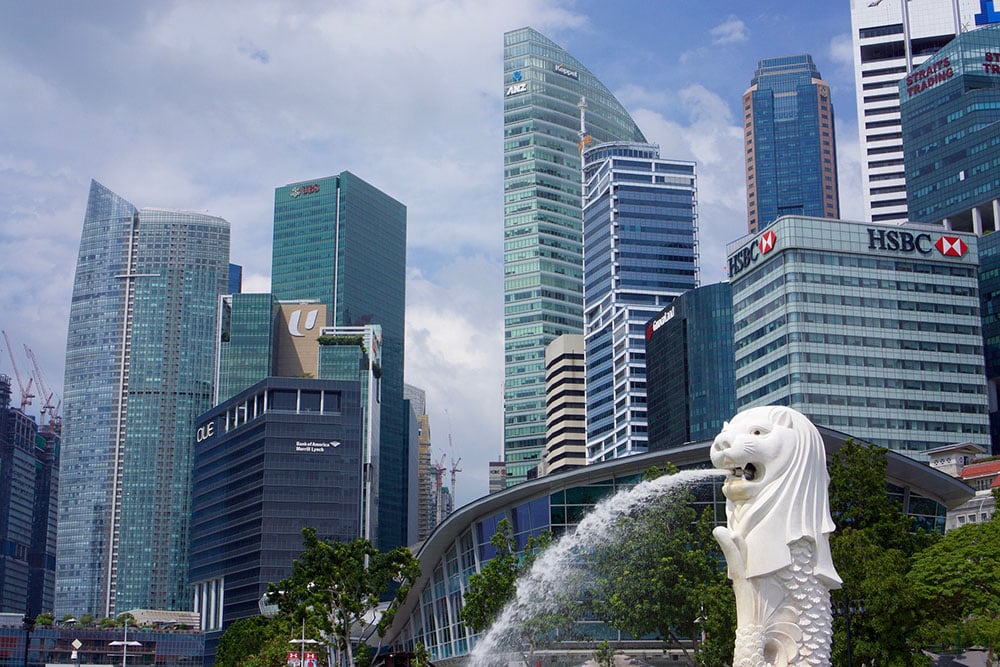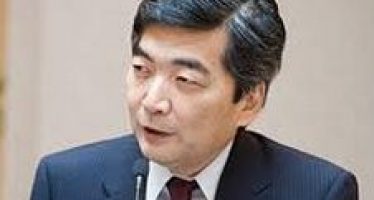Singapore — the leading financial centre in the Asia-Pacific region
Hear the Merlion roar. Singapore is the case study for a DIY global financial centre. It punches above its weight both in terms of financial services and lifestyle. But can it maintain its global and regional importance with the continued rise of Chinese cities likes Shanghai and Shenzhen?
Singapore is the leading financial centre in the Asia-Pacific. It ranks third in the Global Financial Centre Index 2022, trailing only New York and London. It also has overtaken Hong Kong in the last year, with recent changes in Hong Kong hurting its rank.

The financial centre of Singapore with a merlion statue in the foreground
Singapore’s high ranking is based on being well-rounded across several categories. It is ranked third in terms of forex turnover by country (BIS), fourth in terms of the number of ultra-rich residents (Henley), third in terms of financial secrecy (Tax Justice Network), tenth in terms of fintech (Findexable), and has a highly competitive top corporate tax rate of 17 percent, which is almost 9 percent lower than the US rate. It also has the largest REIT market in the region outside of Japan.
Being a city-state, it isn’t the headquarters for many multinationals and its stock market capitalisation ranks only 21st (WFE), but it is home to 2,492 subsidiaries, and stakes a claim to be a leading location for regional headquarters in the Asia-Pacific.
Singapore has long enjoyed being a natural entrepôt based on its location linking the Strait of Malacca in the west and the South China sea in the east. It has also acted as a gateway to resources in the region, particularly petroleum, tin, and rubber.
Sir Thomas Stamford Raffles discovered a small fishing village and recognising the potential of its location, he established a trading post there in 1819. As the trading post grew, it attracted the attention of the British authorities and it became a crown colony in 1867, along with Malacca and Penang. Trade greatly increased after the establishment of Suez Canal in 1869.
With the growth of trade, financial services began to develop to support the trade. Currency services, maritime insurance, and trade finance companies grew along Singapore’s waterfront, which now comprises the city’s financial district.
However, it was not until after its independence from Malaysia in 1965 and the commencement of the government of Lee Kuan Yew and the People’s Action Party (PAP), that Singapore began to emerge as a leading global financial centre.
Lee successfully implemented a series of industrial plans that attracted foreign investment and turned the country into a regional manufacturing and free-trade hub. In its first ten years of independence, the city averaged real GDP growth of 11.4 percent and was soon called an economic miracle. This economic growth was a spur to the city’s financial sector.
Lee also made key strategic decisions to leverage this natural growth to grow financial services. For example, the Asian Dollar Market was established in 1968 with the aim of taking advantage of a gap in global trade from the close of the American markets to the opening of the European markets. The local pension fund, the Central Provident Fund (CPF), established in 1955, has also been adapted at certain points to top up local capital markets, including during the severe 1986 recession. The Singaporean dollar was floated in 1973 and exchange controls were liberalised in 1978, long before most other countries. Another example is the selling of government securities to banks from 1987 to aid their liquidity needs, even though the Singaporean government maintains a regular surplus and has no need to issue securities for funding.
The government was also key in establishing world-class institutions to regulate and run financial services, including the Monetary Authority of Singapore (MAS) in 1971, and the Stock Exchange of Singapore in 1973, which later became the Singapore Exchange (SGX) after merging with the derivatives exchange, the Singapore International Monetary Exchange (SIMEX).
The late 1980s marked the internationalisation of Singaporean finance. The 1984-85 recession and financial liberalisation in competing financial centres like Tokyo and Sydney, led to review and reforms in Singapore. Foreign banks were given greater scope and stockbroking was opened to domestic and foreign banks. An asset management industry was also developed. Local banks were also encouraged to combine so they could compete against the foreign banks. Secondary listing of foreign stocks also bolstered the local market.
In the 1990s, the city cultivated the private wealth market and positioned itself as an attractive destination for a growing number of Asian millionaires. This included the adoption of banking secrecy laws and the establishment of the privately-owned Le Freeport, a high-security vault service for the storage of physical valuables, including gold, gems, and artwork.
In recent years, the government and MAS have been investing in digital financial infrastructure and regulations to promote financial innovation, including the development of fintech hubs. It has also bolstered its anti-money laundering monitoring.
On 15 September 2022, MAS launched its “Financial Services Industry Transformation Map 2025” to take Singapore’s financial services into the next century. Emphasis is given to the further development of the insurance, private capital, and fintech sectors.
The development of Singapore’s financial centre has also been spurred by the country’s investment in local education and the targeting of immigrants with key financial skills and networks. In the latest PISA report by the OECD, Singaporean high school students ranked second in the world in reading, science, and mathematics.
Singapore is however more than a financial centre. It has also transformed itself into a top tourist destination and a destination for expats. Attractions include Sentosa Island, Marina Bay Sands, Orchard Road for shopping, and the Singapore Zoo. Singapore airport is also among the biggest and best in the world.
Despite its high-rises, 47 percent of its land area is covered by trees, and it plans to have a 1,300km cycle path network by 2030.
It is ranked fifth in the region for its quality of living (Mercer) but boasts the second most efficient healthcare system in the world (Bloomberg), the second-best high school education, and the top urban mobility. It also regularly voted the safest city in the world. Living in Singapore is perfect for families. Singapore lifestyle is also unique with its mix of regional cuisines and cultures.
Singapore is however an expensive city. It ranks eight on Mercer’s cost of living index. Property is not cheap with prime rentals lagging only Monaco, Hong Kong, London, and New York. It also has the second-longest working hours in Asia after Hong Kong. It does however have the 11th highest average monthly salaries in the world.
It is a good thing that Singapore keeps reinventing itself as a city and financial centre as it is facing strong competition from the Chinese state who has invested heavily in cities such as Shanghai and Shenzhen. These cities are unrecognisable compared to how they looked and what they offered in the 1980s. COVID-19 and the continued strict measures in China, has perhaps given Singapore a reprieve. Singapore’s clean environment and rule of law is also an advantage. But if Singapore wants to maintain its advantage it needs to continue to innovate.
Singapore can also benefit from the growth of its ASEAN neighbours. The growth of a middle and wealthy class in Indonesia and Vietnam can only benefit Singapore as a financial centre. The merlion should continue to roar well into the future.
By Brendan Filipovski
You may have an interest in also reading…
Satoshi Nakamoto: To Be or Not to Be
The dormant P2P Foundation account of Satoshi Nakamoto – the man, or group of people, who invented Bitcoin – sprang
Frontier Asia and Hopes for More Inclusive Growth
The International Monetary Fund (IMF) and the Japan International Cooperation Agency (JICA) on January 28th held a conference in Bangkok,
Kristalina Georgieva
The little blue Audi TT with its stick shift had to be sacrificed to a small electric VW: “I need


















































































